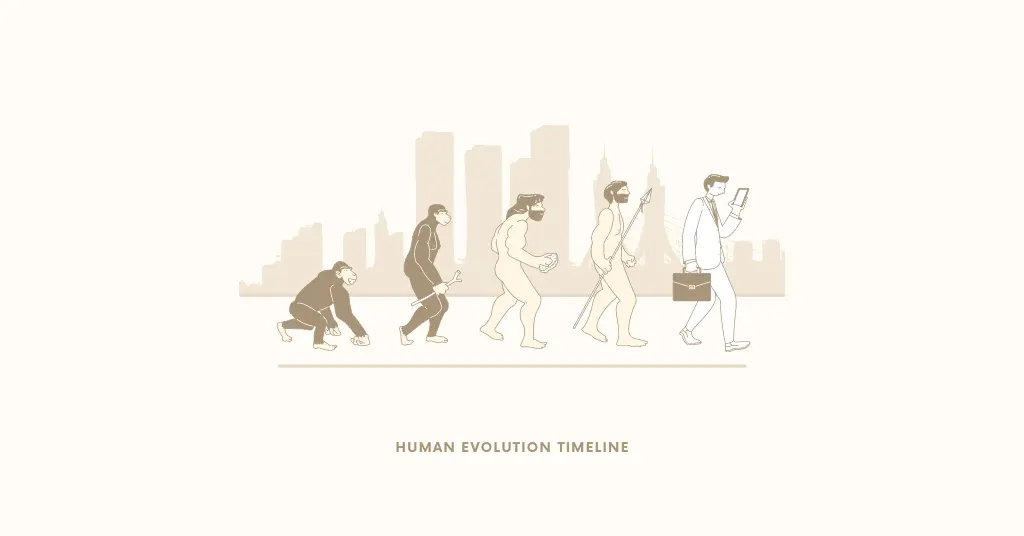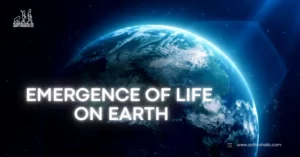AI Answer Evaluation Platform Live Now. Try Free Answer Evaluation Now
Human Evolution Timeline
From the depths of time, human evolution has been a story of wonder, resilience, and adaptation. We, as a species, have come a long way since our early ancestors first walked the earth, navigating the trials and tribulations of survival with intelligence, cooperation, and ingenuity. Our journey from primates to Homo sapiens has been shaped by countless environmental, social, and cultural factors, each leaving its indelible mark on the tapestry of human history.

As we peer back through the mists of time, we see a remarkable story of evolution, with countless twists and turns, triumphs and tragedies, and moments of brilliance and darkness. We see the emergence of language, the invention of tools, the rise of agriculture, the birth of civilization, and the spread of knowledge across the globe. We see a story of adaptation, as our ancestors learned to thrive in diverse ecosystems, from the savannas of Africa to the frozen tundras of the Arctic.
But human evolution is not just a story of the past. It is an ongoing process, as we continue to evolve and adapt to the ever-changing world around us. Our species has faced countless challenges, from disease and war to environmental degradation and climate change, but we have persevered, drawing on our collective knowledge and resilience to forge ahead.
https://www.instagram.com/p/Crnpd6gPflc/
In this journey through human evolution, we will explore the milestones that have shaped our species, from the emergence of bipedalism to the development of complex societies. We will examine the scientific discoveries that have shed light on our origins, and the cultural and social factors that have shaped our identity. And we will reflect on the lessons that our evolutionary history can teach us, as we navigate the challenges of the present and look towards the future.[1]
Human Evolution Timeline
The human evolution timeline from 33,100 years ago marks a pivotal moment in the history of our species. At this time, anatomically modern humans, Homo sapiens, had already emerged in Africa and began migrating across the globe. The period from 33,100 years ago saw a series of developments and transformations that shaped the course of human history.
One of the most significant events during this time was the emergence of the Upper Paleolithic culture in Europe. This cultural period, which lasted from about 40,000 to 10,000 years ago, saw a burst of innovation, artistic expression, and technological advancements. Upper Paleolithic humans developed new tools, such as the bow and arrow and harpoons, which allowed for more efficient hunting and fishing. They also created stunning works of art, such as cave paintings and carvings, which provide insights into their beliefs and worldviews.[3]
The period from 33,100 years ago also saw the spread of humans across the globe. By this time, Homo sapiens had already migrated out of Africa and had reached Europe and Asia. In Asia, they encountered the Neanderthals, who had been living in the region for hundreds of thousands of years. These encounters likely led to interbreeding between the two groups, as evidenced by the genetic legacy of Neanderthals in modern humans.
Furthermore, the period from 33,100 years ago saw the development of agriculture and the rise of complex societies. Humans began to domesticate plants and animals, which led to a surplus of food and a shift towards settled lifestyles. This, in turn, allowed for the development of cities and civilizations, such as the ancient civilizations of Mesopotamia and Egypt.
The human evolution timeline from 33,100 years ago marks a crucial moment in the history of our species. It was a time of great innovation, cultural exchange, and expansion, which set the stage for the development of the modern world.
Some of the major milestones of human evolution:
1. Bipedalism: Around 6 million years ago, early hominids evolved the ability to walk upright on two legs, freeing up their hands for tool use and other tasks.
2. Tool use: Homo habilis, who lived around 2.8 million years ago, is credited with being the first hominid to use stone tools.
3. Brain development: The human brain has tripled in size over the last 2.5 million years, allowing for increased intelligence and problem-solving abilities.
4. Control of fire: Evidence suggests that humans began using fire around 1 million years ago, providing warmth, protection, and a way to cook food.
5. Language development: The emergence of language, which likely began around 50,000-100,000 years ago, allowed for increased communication and social cohesion.
6. Agriculture: Humans began domesticating plants and animals around 10,000 years ago, leading to the development of agriculture and settled societies.
7. Civilization: The development of complex societies, characterized by cities, writing, and specialized labor, began around 5,000 years ago in Mesopotamia and Egypt.
8. Industrial Revolution: The Industrial Revolution, which began in the 18th century, marked a major shift towards mechanized production and mass manufacturing.
9. Space exploration: In the 20th century, humans achieved a major milestone by sending astronauts to the moon and launching space probes to explore our solar system and beyond.
Conclusion
In conclusion, the story of human evolution is a fascinating and complex one, spanning millions of years and countless developments and transformations. From our earliest hominid ancestors to modern humans, our species has evolved and adapted to changing environments and challenges, developing new skills and technologies along the way.
Throughout this evolution, humans have shown an incredible capacity for innovation, creativity, and adaptability. We have developed language and culture, created art and music, and built complex societies and civilizations. We have explored the depths of the ocean and the vast expanse of space, pushing the limits of what we thought was possible.
However, as we look to the future, it is important to remember that our journey is far from over. We continue to face new challenges and opportunities, from climate change and technological advancements to questions about our place in the universe. As we move forward, it will be up to us to use our intelligence and ingenuity to shape the course of our evolution, and to ensure a bright and prosperous future for generations to come.
Reference
[1] Matthijs, A. (2019, January 1). It’s in our genes: Implications of the theory of evoluition for existentialism. It’s in Our Genes: Implications of the Theory of Evoluition for Existentialism. https://studenttheses.uu.nl/handle/20.500.12932/33100
[2] Variability in Early Ahmarian lithic technology and its implications for the model of a Levantine origin of the Protoaurignacian. (2015, April 26). Variability in Early Ahmarian Lithic Technology and Its Implications for the Model of a Levantine Origin of the Protoaurignacian – ScienceDirect. https://doi.org/10.1016/j.jhevol.2015.02.017
[3] Human evolution. (2021, November 3). Human Evolution | Natural History Museum. https://www.nhm.ac.uk/discover/human-evolution.html



